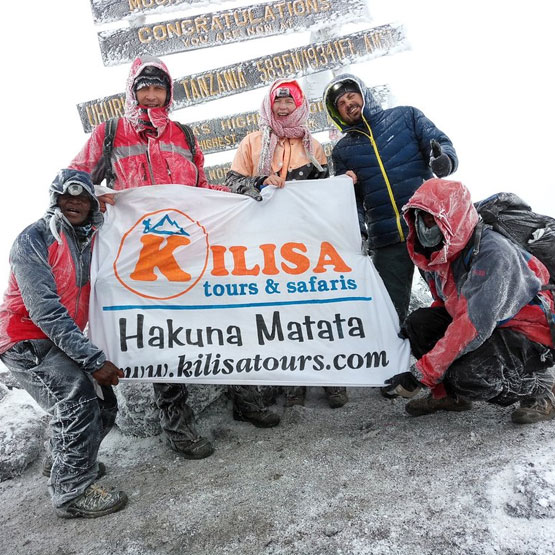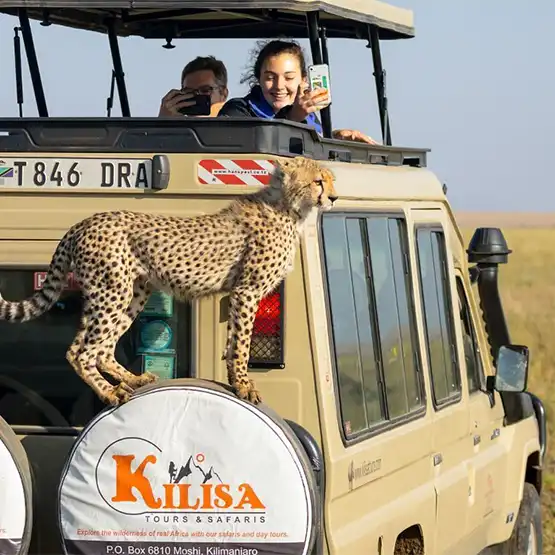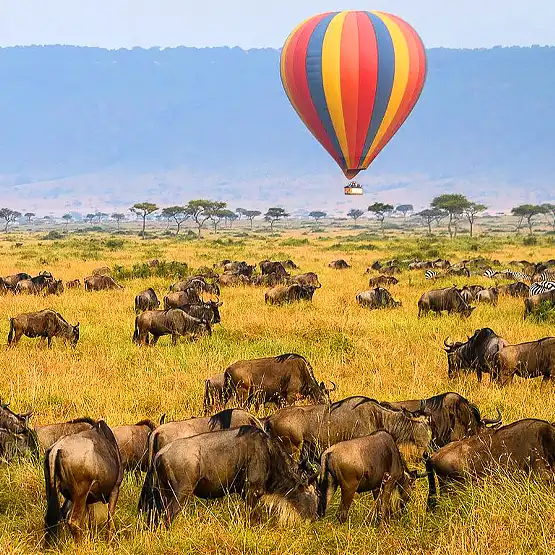How would you choose between witnessing the Great Migration in Serengeti or beholding the world’s largest intact caldera at Ngorongoro? For safari enthusiasts, it’s like choosing between two equally magnificent treasures. Both destinations present unique and unparalleled experiences, and the choice can be surprisingly tricky even for seasoned travelers.
The Serengeti, renowned for its endless plains and the dramatic Wildebeest Migration, offers a compelling spectacle of nature in motion. Covering an expansive 14,763 square kilometers, it’s teeming with wildlife all year round. On the other hand, Ngorongoro Crater, formed around two to three million years ago, is a sanctuary for a variety of species within its 260 square kilometers. With almost 25,000 large animals living within the crater, it’s a concentrated burst of wildlife diversity worth witnessing.
Serengeti or Ngorongoro – Which Safari Should I Book First?
Choosing between Serengeti and Ngorongoro for your first safari can be a tough decision. Each offers unique experiences that cater to different interests. The Serengeti is famous for its vast plains and the Great Migration, where millions of animals move across the landscape. On the other hand, Ngorongoro is home to the world’s largest volcanic caldera, providing a concentrated burst of diverse wildlife. Both destinations promise unforgettable adventures.
One key factor to consider is the wildlife density. Serengeti’s endless plains make it easier to spot large herds of wildebeest, zebras, and gazelles. During the calving season, the area is teeming with newborns, which can be a spectacular sight. According to this post, the migration peak attracts numerous predators, offering thrilling opportunities for wildlife photography. Ngorongoro, with its enclosed crater, allows for an equally rich but more concentrated wildlife experience.
Another consideration is the timing of your visit. The Serengeti’s migration is a year-long event, with different highlights depending on the season. In contrast, Ngorongoro’s wildlife is relatively stable throughout the year, making it a dependable option. If you prefer a specific type of wildlife experience, such as watching the calving season, Serengeti might be your first choice. Both locations have their peak months, which can significantly affect your safari experience.
Ultimately, whether you choose Serengeti or Ngorongoro may depend on what kind of safari adventure you’re seeking. If witnessing the massive herds of the Great Migration excites you, Serengeti is the spot. For a unique experience in a natural coliseum teeming with varied wildlife, Ngorongoro is ideal. Both provide exceptional opportunities, ensuring your safari with Kilisa Tours will be memorable.
Understanding the Unique Appeal of Serengeti and Ngorongoro
The Serengeti is known for its vast, open plains that stretch as far as the eye can see. It’s a place where you can witness the dramatic Great Migration, one of the most remarkable wildlife events on the planet. This spectacle sees over 1.5 million wildebeest, along with hundreds of thousands of zebras and gazelles, journeying in search of greener pastures. Visitors often find the sheer scale and beauty of the migration breathtaking. The Serengeti also offers stunning sunsets, setting the perfect backdrop for an unforgettable safari.
Ngorongoro, on the other hand, is home to an ancient volcanic caldera known as the Ngorongoro Crater. This crater is the world’s largest unbroken, unflooded volcanic caldera, offering a unique and concentrated wildlife experience. Inside this natural fortress, you can find an incredible diversity of animals, including the Big Five – lions, leopards, elephants, rhinos, and buffalo. The density of wildlife within the crater is unmatched, making it a prime spot for game viewing. The lush landscape of the crater adds to its enchanting appeal.
Both Serengeti and Ngorongoro have their distinctive charms, influenced by their unique landscapes and ecosystems. While Serengeti’s open plains showcase the grand scale of nature, Ngorongoro’s enclosed crater provides an intimate encounter with wildlife. Your personal preference might lean towards the vastness and action of the Serengeti or the compact, immersive experience in Ngorongoro. Each destination offers something special for every type of traveler.
The choice between Serengeti and Ngorongoro also extends to the types of activities available at each location. In the Serengeti, travelers can enjoy hot air balloon safaris that offer a bird’s-eye view of the migrating herds. Additionally, both locations are renowned for guided game drives, which are perfect for spotting diverse species and learning from knowledgeable guides. Each park provides various ways to experience the magic of the African wilderness, whether you prefer the expansive openness of the Serengeti or the concentrated sanctuary of Ngorongoro.
Wildlife Diversity and Density in Serengeti vs Ngorongoro
The Serengeti is renowned for its incredible wildlife diversity. It boasts over 500 species of birds and 70 species of large mammals. This vast ecosystem supports iconic animals like lions, cheetahs, and elephants. The annual Great Migration sees over 1.5 million wildebeest, 200,000 zebras, and countless other animals moving in a dramatic survival journey. It’s a sight that truly showcases the Serengeti’s rich biodiversity.
Ngorongoro Crater, although smaller in size, offers an impressive density of wildlife. Within its 260 square kilometers, the crater is home to nearly 25,000 large animals. This includes all members of the Big Five, making it easier for visitors to spot these majestic creatures. The crater’s walls create a natural enclosure, ensuring the wildlife is both abundant and accessible. Visitors often find the close encounters with animals in Ngorongoro truly unique.
The differences in landscapes between the Serengeti and Ngorongoro also impact the type of wildlife found in each. Serengeti’s open plains are ideal for grazing animals like zebras, gazelles, and wildebeests. The vast space allows predators such as lions and cheetahs to hunt efficiently. Meanwhile, Ngorongoro’s diverse terrain includes forests, swamps, and grasslands, supporting varied species from flamingos to hippos. This variation adds to the crater’s ecological richness.
Both locations offer unique wildlife experiences that cater to different preferences. While the Serengeti provides a sweeping view of wildlife in motion, Ngorongoro offers a concentrated burst of biodiversity. Depending on what you’re looking for in a safari, each has its distinct advantages. Exploring both could give a comprehensive view of Tanzania’s remarkable wildlife.
Best Time to Visit Serengeti and Ngorongoro
Timing is crucial when planning a safari to Serengeti and Ngorongoro. The best time to visit the Serengeti largely depends on the Great Migration. Between June and July, you can witness the dramatic river crossings. Calving season, when wildebeest give birth to thousands of calves, occurs in January and February. Each phase of the migration offers a unique spectacle.
Ngorongoro Crater, however, has more consistent wildlife viewing year-round. The months from June to October, during the dry season, are particularly favorable. During this time, animals congregate around water sources, making them easier to spot. The weather is also mild, with clear skies and less rainfall. Even in the wet season, Ngorongoro remains a lush paradise full of life.
Visitor preferences for specific wildlife activities can influence the best time to visit. For instance, those interested in birdwatching should consider the wet season from November to April. This period attracts migratory birds and displays a variety of species. Photographers might prefer the dry season for clearer views and vibrant landscapes. Both parks offer peak months tailored to different interests.
Weather patterns also play a critical role in planning your visit. Serengeti’s dry season, from late June to October, provides the best game viewing opportunities as animals gather around dwindling water sources. In contrast, the wet season brings lush landscapes but can make some roads impassable. Ngorongoro’s higher elevation means it’s cooler year-round, with more predictable weather patterns. This consistently favorable climate adds to the crater’s appeal.
Considering both locations’ peak seasons, visitors should plan based on their personal preferences and interests. Families might enjoy the quieter seasons with fewer tourists, while adventure seekers may relish the excitement of peak migration times. Each period offers distinct experiences, making Tanzania’s national parks a year-round destination. Planning with Kilisa Tours ensures a well-timed, unforgettable safari.





